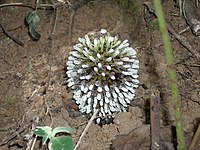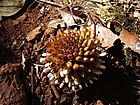Note: This is a project under development. The articles on this wiki are just being initiated and broadly incomplete. You can Help creating new pages.
Difference between revisions of "Balanophora Fungosa"
(→References) |
(→Parts Used) |
||
| (2 intermediate revisions by the same user not shown) | |||
| Line 6: | Line 6: | ||
==Parts Used== | ==Parts Used== | ||
| − | {{Parts Used|Root}} | + | {{Parts Used|Root}}, {{Parts Used|Whole plant}} |
==Chemical Composition== | ==Chemical Composition== | ||
| Line 12: | Line 12: | ||
==Common names== | ==Common names== | ||
| − | {{Common names|sa=Gaja Pippali, Markata Pippali|en=|gu=|hi=Gaja Pippali|kn=Markata Pippali, Gaja Pippali|ks=|ml=|mr=|pa=|ta=Ati Tippali|te=Veerchedi}}<ref name="Karnataka Medicinal Plants"/> | + | {{Common names|sa=Gaja Pippali, Markata Pippali|en=Fungus Root|gu=|hi=Gaja Pippali|kn=Markata Pippali, Gaja Pippali|ks=|ml=|mr=|pa=|ta=Ati Tippali|te=Veerchedi}}<ref name="Karnataka Medicinal Plants"/> |
==Properties== | ==Properties== | ||
Latest revision as of 11:31, 22 July 2024
Balanophora fungosa is a fleshy, leafless herb that is total parasitic on the roots or rhizomes of various host species. A perennial plant growing from a tuberous rootstock, it grows up to 15cm tall. The roots of at least one form of this plant are harvested locally for their wax, which is used for lighting purposes.
Contents
- 1 Uses
- 2 Parts Used
- 3 Chemical Composition
- 4 Common names
- 5 Properties
- 6 Habit
- 7 Identification
- 8 List of Ayurvedic medicine in which the herb is used
- 9 Where to get the saplings
- 10 Mode of Propagation
- 11 How to plant/cultivate
- 12 Commonly seen growing in areas
- 13 Photo Gallery
- 14 References
- 15 External Links
Uses
Parts Used
Chemical Composition
It contains phenolic compounds Isolariciresinol, Gallic acid, Pinoresinol, Methyl caffeate, and Epipinoresinol, Glucopyranoside were isolated from Balanophora fungosa.[2]
Common names
| Language | Common name |
|---|---|
| Kannada | Markata Pippali, Gaja Pippali |
| Hindi | Gaja Pippali |
| Malayalam | |
| Tamil | Ati Tippali |
| Telugu | Veerchedi |
| Marathi | |
| Gujarathi | |
| Punjabi | |
| Kashmiri | |
| Sanskrit | Gaja Pippali, Markata Pippali |
| English | Fungus Root |
Properties
Reference: Dravya - Substance, Rasa - Taste, Guna - Qualities, Veerya - Potency, Vipaka - Post-digesion effect, Karma - Pharmacological activity, Prabhava - Therepeutics.
Dravya
Rasa
Guna
Veerya
Vipaka
Karma
Prabhava
Habit
Identification
Leaf
| Kind | Shape | Feature |
|---|---|---|
Flower
| Type | Size | Color and composition | Stamen | More information |
|---|---|---|---|---|
| Flowering from September to January | {{{5}}} |
Fruit
| Type | Size | Mass | Appearance | Seeds | More information |
|---|---|---|---|---|---|
| Fruiting from September to January |
Other features
List of Ayurvedic medicine in which the herb is used
Where to get the saplings
Mode of Propagation
How to plant/cultivate
Commonly seen growing in areas
Photo Gallery
References
External Links
- Ayurvedic Herbs known to be helpful to treat Wound
- Ayurvedic Herbs known to be helpful to treat Piles
- Herbs with Root used in medicine
- Herbs with Whole plant used in medicine
- Herbs with common name in Kannada
- Herbs with common name in Hindi
- Herbs with common name in Tamil
- Herbs with common name in Telugu
- Herbs with common name in Sanskrit
- Herbs with common name in English
- Habit - Perennial
- Index of Plants which can be propagated by Seeds
- Herbs that are commonly seen in the region of Evergreen rainforests
- Herbs
- Pages without herbs images





